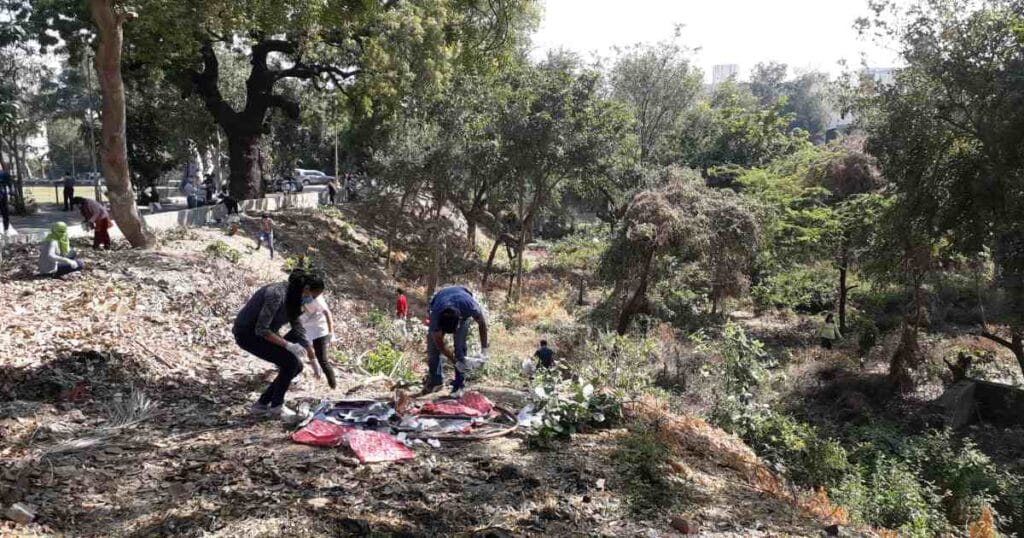
COMPETITIVE EXAM MCQs SERIES of ENVIRONMENTAL SCIENCE for UGC-NET/JRF, SLET, ARS, GATE, and other entrance tests – Contemporary Environmental Issues: Environmental Challenges of Waste Management.
Syllabus Outline
- Environmental and health impacts of improper waste management
- Waste collection, segregation, storage, and transportation challenges
- Specific challenges in managing hazardous and biomedical waste
- Community-based waste management and Swachh Bharat Mission
- Waste infrastructure gaps and informal waste workers.
This quiz contains concept-based, most frequently asked 25 MCQs of “Contemporary Environmental Issues: Environmental Challenges of Waste Management”. Each question has a single correct/most appropriate answer.
*****
1. In the anaerobic decomposition of organic waste in landfills, which gas is produced in the largest volume?
A) Carbon dioxide
B) Methane
C) Nitrous oxide
D) Hydrogen sulfide
2. Open burning of municipal waste commonly releases which of these hazardous pollutants?
I – Dioxins and furans
II – Particulate matter
III – Carbon monoxide
IV – Carbon Dioxide
A) I only
B) I and II
C) I, II and III
D) I, II, III and IV
3. Contamination of drinking water by landfill leachate rich in nitrates primarily leads to:
A) Skin rashes
B) Gastrointestinal disorders
C) Respiratory problems
D) Hearing loss
4. The characteristic “rotten egg” odour around landfills is due to the presence of which gas?
A) Ammonia
B) Hydrogen sulfide
C) Methane
D) Carbon dioxide
5. Over a 100-year time horizon, methane’s global warming potential is roughly how many times that of carbon dioxide?
A) 5 times
B) 10 times
C) 25 times
D) 100 times
6. Which of the following are common constituents of landfill leachate?
I – Heavy metals
II – Nitrate compounds
III – Methane gas
IV – Pathogenic bacteria and viruses
A) I, II and IV only
B) I, II and III only
C) I, III and IV only
D) All of the above
7. Which of the following substances is least likely to be present in significant concentration in landfill leachate?
A) Lead
B) Nitrates
C) Pesticide residues
D) Glucose
8. Roughly what percentage by volume of typical landfill gas is methane?
A) 10%
B) 25%
C) 50%
D) 75%
9. Door-to-door waste collection by local authorities is important because it:
A) Eliminates the need for households to segregate waste
B) Encourages segregation of waste at source
C) Increases the total volume of waste collected
D) Requires no government oversight
10. A major challenge in waste transportation includes:
I – Spillage of waste during transit
II – Emissions of greenhouse gases by transport vehicles
III – Overly strict enforcement of transport regulations
IV – Poor Road access to waste sites
A) I only
B) I and II
C) I, II and III
D) I, II and IV
11. In India’s annual cleanliness survey of cities, which factor contributes to a top ranking?
I – Efficient door-to-door collection of waste
II – Source segregation of waste
III – Reliance on landfilling of waste
IV – Active citizen participation in waste reduction
A) I only
B) I and II
C) I, II and IV
D) I, II, III and IV
12. The “waste bank” model in community waste management typically refers to:
A) Households depositing recyclables in exchange for cash
B) A centralised city landfill facility to reduce the maintenance cost
C) Importing waste from other cities for revenue
D) A common waste bin in society avoids door-to-door collection to reduce the cost of waste collection
13. Extended Producer Responsibility in waste management means that:
A) Producers are responsible for the end-of-life management of their products
B) Producers must buy back products from consumers
C) Producers are absolved of post-consumer waste issues
D) Producers should pay municipalities to handle end-of-life disposal of their products
14. According to India’s E-Waste (Management) Rules, 2022, producers should collect e-waste equivalent to:
A) 10% of sales
B) 20% of sales
C) 50% of sales
D) 80% of sales
15. Which of the following is not classified as hazardous waste?
A) Spent engine oil
B) Household wastewater under black categories
C) Empty pesticide containers
D) Industrial chemical solvents
16. In biomedical waste management, autoclaving is primarily used to:
A) Incineration of chemical waste
B) Sterilise infectious waste materials
C) Remove heat-sensitive toxins from biomedical waste
D) Facilitate segregation of infectious and non-infectious waste.
17. Used hypodermic needles from hospitals in India must be disposed of in:
A) Yellow bags
B) Red bags
C) White puncture-proof containers
D) Blue glass containers
18. Hospital waste generated from diagnostic or therapeutic procedures containing radioactive materials should be classified as:
A) Biomedical waste
B) Hazardous waste
C) Special radioactive waste
D) Non-Recyclable waste
19. Which type of biomedical waste is typically treated by autoclaving rather than incineration?
A) Human anatomical waste
B) Infectious plastic waste
C) Chemical liquid waste
D) Radioactive waste
20. Which ministry oversees the Swachh Bharat Mission-Gramin?
A) Ministry of Housing and Urban Affairs
B) Ministry of Defence
C) Ministry of Jal Shakti
D) Ministry of Education
21. According to a 2024 UNEP report, global municipal solid waste generation is projected to reach approximately how many billion tonnes per year by 2050 under business-as-usual?
A) 2.1 B tonnes
B) 3.8 B tonnes
C) 5.0 B tonnes
D) 7.2 B tonnes
22. The “3Rs” of waste management stand for:
A) Reduce, Reuse, Recycle
B) Remove, Recover, Release
C) Reforest, Reclaim, Reinvent
D) Refuse, Replace, Reduce
23. In India’s Solid Waste Management Rules, 2016, a key mandate is:
A) All waste must be collected by municipalities
B) Segregation of waste at source
C) Plastic waste must be recycled under the extended producer’s responsibilities
D) E-waste end-of-life cycle must be handled under the extended producer’s responsibilities
24. What is the primary environmental concern of improper secure landfilling?
A) Reduced soil fertility
B) Groundwater contamination
C) Increased air pollution
D) Loss of biodiversity
25. Palletisation is used to:
A) Securing the toxic chemical layer of the top soil
B) Recycling solid waste under anaerobic conditions
C) Produce Refuse-derived fuel from solid waste
D) Stimulate biodegradation by adding a suitable microorganism
*****
Previous: Forest Conservation and Wildlife Conservation Projects
Next: Environmental Disasters and Their Management
References
- R. Rajagopalan (2015) ENVIRONMENTAL STUDIES: FROM CRISIS TO CURE, Oxford University Press, Third edition
- Bharucha, E. (2013). Textbook of Environmental Studies. Universities Press, 3rd edition
- Abha Vashistha and Surabhi Johari (2020). Contemporary Environmental Issues and Challenges, Bloomsbury Prime
- William Cunningham and Mary Cunningham (2009) Environmental Science: A Global Concern, McGraw-Hill Education, 11th edition

